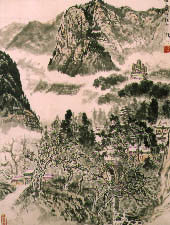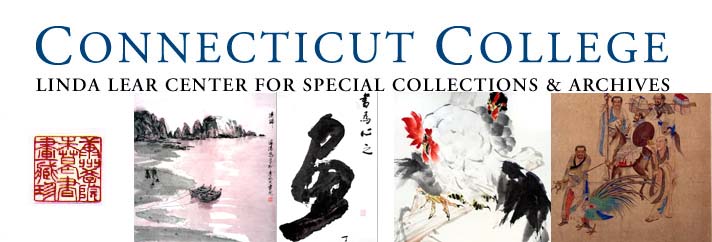Landscape Paintings
Chang Ting (b. 1917)
Hanging Scroll, Ink and Color on Rice Paper, 18 x 13.5 in., (45.75 x 34.5 cm.)
 During the past seventy-two years, Chang Ting's life has turned and twisted with the history of China. In 1913, when the Japanese army occupied his birthplace, Chang escaped to Peking, where he studied painting and cartoon drawing. In 1937, he taught at the Lu Hsun Institute of Literature and Art in Yenan, stronghold of Mao Tse Tung.
During the past seventy-two years, Chang Ting's life has turned and twisted with the history of China. In 1913, when the Japanese army occupied his birthplace, Chang escaped to Peking, where he studied painting and cartoon drawing. In 1937, he taught at the Lu Hsun Institute of Literature and Art in Yenan, stronghold of Mao Tse Tung.
In 1954, the Communist government sent him to Italy and France, where he met Picasso. After his European trip, Chang's paintings became more colorful, often including elements of Chinese folk art. For several years during the cultural revolution (1966-1976), he was restricted to the countryside without any painting supplies. But three years after he was "rehabilitated" he was made president of the Central Academy of Arts and Crafts, and led a group of faculty and students to paint the famous "Necha Defeats the Dragon King" mural at Peking airport.
Dai-chien began as an artist in his early years. Born in a rich and educated family, he was taught to paint by his mother. After he went to high school and later to Kyoto to study for four years, be began his formal painting instruction under two Shanghai artists. Dai-chien's favorite artist, Shih Tao (1641-c.1717), was a great influence to him. Dai-chien copied Shih Tao's work and at a young age he became a connoisseur and began to collect ancient Chinese paintings. By the time the war started in 1937, he already had twenty-four boxes of treasured pieces, some of which later became his major source of income for a comfortable lifestyle abroad, in Brazil and Carmel, CA.
Our piece was done in the early seventies when Chang Ting's painting reflected the sadness of his life. Chang began to use scorched ink and a dry brush to render the texture of rocks and to reflect his austere life. Now Chang Ting lives comfortably in Beijing, enjoying his retirement and his reputation as a leader in art and art education.
This painting was purchased with funds provided by Richard and Esther Goodwin in October, 1988.
